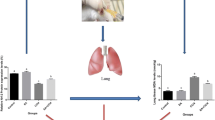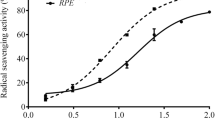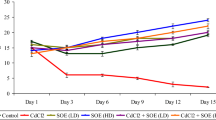Abstract
Induction of oxidative stress and inflammation are considered the primary mechanism of cadmium (Cd) toxicity. Nigella sativa (NS) seeds and their oil (NSO) have been reported to possess antioxidant and anti-inflammatory potential. This study was conducted to assess the protective effect of NSO on Cd-induced lung damage in rat. Forty adult male Wistar rats were divided equally into 4 groups. Animals in groups I, II, and III received 1 ml of isotonic saline intraperitoneally (IP), 2 mg/kg of cadmium chloride (CdCl2) dissolved in isotonic saline IP, and 1 ml/kg of NSO by gastric gavage, respectively. Group IV rats received NSO an hour prior to CdCl2 administration via the same routes and doses as previously described. All animals were treated for 28 days. At the end of the study, animals were sacrificed; lungs were harvested for histopathological studies using light and electron microscopy. Saline-treated and NSO-treated rats showed normal lung parenchyma. However, CdCl2-treated rats showed massive degenerative changes in alveolar epithelial lining, disrupted interalveolar septa, and hemolytic debris in alveoli. Rats treated with both NSO and CdCl2 (group IV) showed amelioration of most Cd-induced lung damage with minimal histopathological changes in lung architecture. This study elucidates the protective effects of NSO on Cd-induced lung injury in rats and highlights the possibility of using NSO as a protective agent in individuals at high risk of Cd-induced lung toxicity.







Similar content being viewed by others
References
Abdel-Aziz M, Abass A, Zalata K, Abd Al-Galel T, Allam U, Karrouf G (2014) Effect of dexamethasone and Nigella sativa on inducible nitric oxide synthase in the lungs of a murine model of allergic asthma. Iran J Allergy Asthma Immunol 13(5):324–334
Ahmad A, Husain A, Mujeeb M, Khan SA, Najmi AK, Siddique NA, Damanhouri ZA, Anwar F (2013) A review on therapeutic potential of Nigella sativa: a miracle herb. Asian Pac J Trop Biomed 3(5):337–352
Akesson A, Barregard L, Bergdahl IA, Nordberg GF, Nordberg M, Skerfving S (2014) Non-renal effects and the risk assessment of environmental cadmium exposure. Environ Health Perspect 122(5):431–438
Al-Ali A, Alkhawajah AA, Randhawa MA, Shaikh NA (2008) Oral and intraperitoneal LD50 of thymoquinone, an active principle of Nigella sativa, in mice and rats. J Ayub Med Coll Abbottabad 20(2):25–27
Al-Ghamdi MS (2001) The anti-inflammatory, analgesic and antipyretic activity of Nigella sativa. J Ethnopharmacol 76(1):45–48
Al-Johany AM, Haffor AS (2009) Effects of cadmium exposure on the ultrastructural pathology of different pulmonary cells, leukocyte count, and activity of glutathione peroxidase and lactate dehydrogenase in relation to free radical production in Uromastyx aegyptius. Ultrastruct Pathol 33(2):39–47
Arif M, Thakur SC, Datta K (2016) Implication of thymoquinone as a remedy for polycystic ovary in rat. Pharm Biol 54(4):674–685
Bancroft JD, Stevens A (1996) Theory and practice of histological techniques. Churchill Livingstone, New York
Butt MS, Sultan MT (2010) Nigella sativa: reduces the risk of various maladies. Crit Rev Food Sci Nutr 50(7):654–665
Cao Y, Chen A, Radcliffe J, Dietrich KN, Jones RL, Caldwell K, Rogan WJ (2009) Postnatal cadmium exposure, neurodevelopment, and blood pressure in children at 2, 5, and 7 years of age. Environ Health Perspect 117(10):1580–1586
Chehl N, Chipitsyna G, Gong Q, Yeo CJ, Arafat HA (2009) Anti-inflammatory effects of the Nigella sativa seed extract, thymoquinone, in pancreatic cancer cells. HPB (Oxford) 11(5):373–381
Chen L, Liu L, Huang S (2008) Cadmium activates the mitogen-activated protein kinase (MAPK) pathway via induction of reactive oxygen species and inhibition of protein phosphatases 2A and 5. Free Radic Biol Med 45(7):1035–1044
Colacino JA, Arthur AE, Ferguson KK, Rozek LS (2014) Dietary antioxidant and anti-inflammatory intake modifies the effect of cadmium exposure on markers of systemic inflammation and oxidative stress. Environ Res 131:6–12
Cuypers A, Plusquin M, Remans T, Jozefczak M, Keunen E, Gielen H, Opdenakker K, Nair AR, Munters E, Artois TJ, Nawrot T, Vangronsveld J, Smeets K (2010) Cadmium stress: an oxidative challenge. Biometals 23(5):927–940
Damiano VV, Cherian PV, Frankel FR, Steeger JR, Sohn M, Oppenheim D, Weinbaum G (1990) Intraluminal fibrosis induced unilaterally by lobar instillation of CdCl2 into the rat lung. Am J Pathol 137(4):883–894
Djukic-Cosic D, Curcic Jovanovic M, Plamenac Bulat Z, Ninkovic M, Malicevic Z, Matovic V (2008) Relation between lipid peroxidation and iron concentration in mouse liver after acute and subacute cadmium intoxication. J Trace Elem Med Biol 22(1):66–72
Entok E, Ustuner MC, Ozbayer C, Tekin N, Akyuz F, Yangi B, Kurt H, Degirmenci I, Gunes HV (2014) Anti-inflammatuar and anti-oxidative effects of Nigella sativa L.: 18FDG-PET imaging of inflammation. Mol Biol Rep 41(5):2827–2834
Goldfrank LR, Flomenbaum NE, Lewin NA (2006) Toxicologic emergencies. McGraw-Hill, New York
Hadi V, Kheirouri S, Alizadeh M, Khabbazi A, Hosseini H (2016) Effects of Nigella sativa oil extract on inflammatory cytokine response and oxidative stress status in patients with rheumatoid arthritis: a randomized, double-blind, placebo-controlled clinical trial. Avicenna J Phytomed 6(1):34–43
Hayat MA (1978) Principles and techniques of electron microscopy: biological applications. New York. Van Nostrand Reinhold, London
Houghton PJ, Zarka R, de las Heras B, Hoult JR (1995) Fixed oil of Nigella sativa and derived thymoquinone inhibit eicosanoid generation in leukocytes and membrane lipid peroxidation. Planta Med 61(1):33–36
Jihen el H, Imed M, Fatima H, Abdelhamid K (2008) Protective effects of selenium (Se) and zinc (Zn) on cadmium (Cd) toxicity in the liver and kidney of the rat: histology and Cd accumulation. Food Chem Toxicol 46(11):3522–3527
Koyuturk M, Yanardag R, Bolkent S, Tunali S (2007) The potential role of combined anti-oxidants against cadmium toxicity on liver of rats. Toxicol Ind Health 23(7):393–401
Kukongviriyapan U, Pannangpetch P, Kukongviriyapan V, Donpunha W, Sompamit K, Surawattanawan P (2014) Curcumin protects against cadmium-induced vascular dysfunction, hypertension and tissue cadmium accumulation in mice. Nutrients 6(3):1194–1208
Kumar RK, Lykke AW (1995) Messages and handshakes: cellular interactions in pulmonary fibrosis. Pathology 27(1):18–26
Lag M, Rodionov D, Ovrevik J, Bakke O, Schwarze PE, Refsnes M (2010) Cadmium-induced inflammatory responses in cells relevant for lung toxicity: expression and release of cytokines in fibroblasts, epithelial cells and macrophages. Toxicol Lett 193(3):252–260
Lee DH, Lim JS, Song K, Boo Y, Jacobs DR Jr (2006) Graded associations of blood lead and urinary cadmium concentrations with oxidative-stress-related markers in the U.S. population: results from the third National Health and nutrition examination survey. Environ Health Perspect 114(3):350–354
Lin YS, Rathod D, Ho WC, Caffrey JJ (2009) Cadmium exposure is associated with elevated blood C-reactive protein and fibrinogen in the U. S. population: the third national health and nutrition examination survey (NHANES III, 1988-1994. Ann Epidemiol 19(8):592–596
Massadeh AM, Al-Safi SA, Momani IF, Al-Mahmoud M, Alkofahi AS (2007) Analysis of cadmium and lead in mice organs. Biol Trace Elem Res 115(2):157–167
Metodiewa D, Koska C (2000) Reactive oxygen species and reactive nitrogen species: relevance to cyto(neuro)toxic events and neurologic disorders. An overview. Neurotox Res 1(3):197–233
Mohamadin AM, Sheikh B, Abd El-Aal AA, Elberry AA, Al-Abbasi FA (2010) Protective effects of Nigella sativa oil on propoxur-induced toxicity and oxidative stress in rat brain regions. Pestic Biochem Physiol 98(1):128–134
Oh CM, Oh IH, Lee JK, Park YH, Choe BK, Yoon TY, Choi JM (2014) Blood cadmium levels are associated with a decline in lung function in males. Environ Res 132:119–125
Olszowski T, Baranowska-Bosiacka I, Gutowska I, Chlubek D (2012) Pro-inflammatory properties of cadmium. Acta Biochim Pol 59(4):475–482
Ovalle WK, Nahirney PC, Netter FH (2008) Netter’s essential histology. Saunders/Elsevier, Philadelphia
Rastogi L, Feroz S, Pandey BN, Jagtap A, Mishra KP (2010) Protection against radiation-induced oxidative damage by an ethanolic extract of Nigella sativa L. Int J Radiat Biol 86(9):719–731
Rogalska J, Pilat-Marcinkiewicz B, Brzoska MM (2011) Protective effect of zinc against cadmium hepatotoxicity depends on this bioelement intake and level of cadmium exposure: a study in a rat model. Chem Biol Interact 193(3):191–203
Salem ML (2005) Immunomodulatory and therapeutic properties of the Nigella sativa L. Seed. Int Immunopharmacol 5(13–14):1749–1770
Sankaranarayanan C, Pari L (2011) Thymoquinone ameliorates chemical induced oxidative stress and beta-cell damage in experimental hyperglycemic rats. Chem Biol Interact 190(2–3):148–154
Sultan MT, Butt MS, Karim R, Ahmad N, Ahmad RS, Ahmad W (2015) Nigella sativa Fixed and essential oil improves antioxidant status through modulation of antioxidant enzymes and immunity. Pak J Pharm Sci 28(2):589–595
Vaillancourt F, Silva P, Shi Q, Fahmi H, Fernandes JC, Benderdour M (2011) Elucidation of molecular mechanisms underlying the protective effects of thymoquinone against rheumatoid arthritis. J Cell Biochem 112(1):107–117
Wang B, Du Y (2013) Cadmium and its neurotoxic effects. Oxidative Med Cell Longev 2013:898034
Yousefi M, Barikbin B, Kamalinejad M, Abolhasani E, Ebadi A, Younespour S, Manouchehrian M, Hejazi S (2013) Comparison of therapeutic effect of topical Nigella with betamethasone and Eucerin in hand eczema. J Eur Acad Dermatol Venereol 27(12):1498–1504
Zhang W, Fievez L, Cheu E, Bureau F, Rong W, Zhang F, Zhang Y, Advenier C, Gustin P (2010) Anti-inflammatory effects of formoterol and ipratropium bromide against acute cadmium-induced pulmonary inflammation in rats. Eur J Pharmacol 628(1–3):171–178
Author information
Authors and Affiliations
Corresponding author
Ethics declarations
Conflict of interest
The authors declare that they have no conflict of interest.
Funding
This research received no specific grant from any funding agency in the public, commercial, or not-for-profit sectors.
Additional information
Responsible editor: Philippe Garrigues
Rights and permissions
About this article
Cite this article
El-Ebiary, A.A., El-Ghaiesh, S., Hantash, E. et al. Mitigation of cadmium-induced lung injury by Nigella sativa oil. Environ Sci Pollut Res 23, 25356–25363 (2016). https://doi.org/10.1007/s11356-016-7603-3
Received:
Accepted:
Published:
Issue Date:
DOI: https://doi.org/10.1007/s11356-016-7603-3




